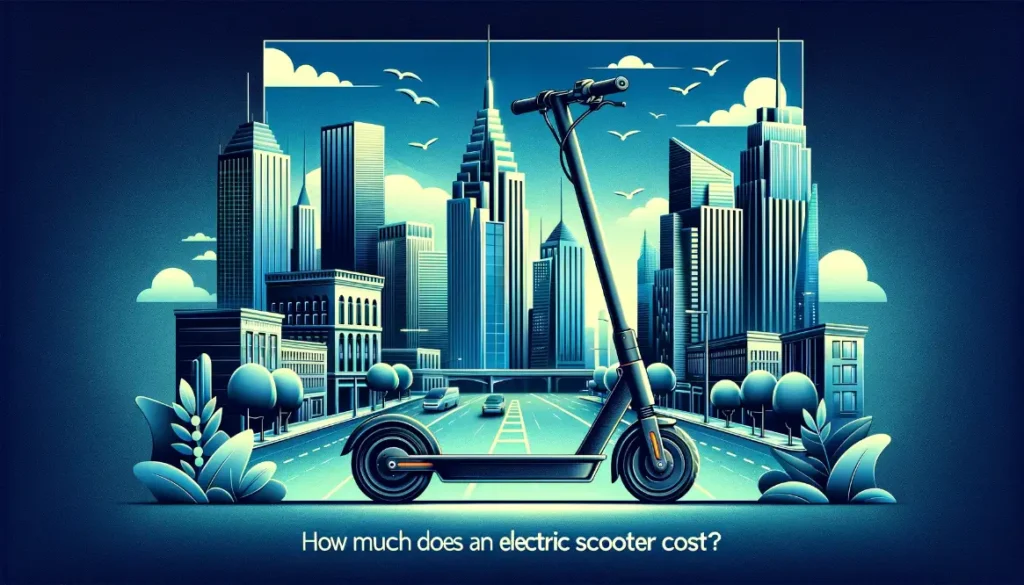
Electric scooters provide an affordable and convenient mode of personal transport. But how much does an electric scooter cost? In this comprehensive guide, we break down e-scooter prices based on their components, features, additional expenses, and more. Read on to find answers to all your questions regarding electric scooter costs.
An Introduction to Electric Scooters
Electric scooters are small, battery-powered two-wheelers that provide zero-emissions urban mobility. Here are some key facts about them:
What are electric scooters?
- Also known as e-scooters, they run on rechargeable lithium batteries instead of gasoline.
- Powered by electric hub motors in the front or rear wheel.
- Speeds range from 10 mph to 30 mph based on local regulations.
- Lightweight, foldable designs allow for easy storage and portability.
Brief history of electric scooters
Electric kick scooters first became popular in the early 2000s. Advancements in lithium batteries, motors, controllers, and material technology have since then vastly improved their capabilities while reducing costs.
Their surging popularity as an urban mobility solution has led to large investments and expanding opportunities. The global e-scooter market is projected to grow from $17 billion in 2019 to over $42 billion by 2025.
Types of Electric Scooters
There are a few broad categories of e-scooters based on their design and functioning. Their pricing can vary significantly.
Standing electric scooters
These are the most common. They have a wide deck to stand on and handlebars to steer. Budget options start from $200, while high-performance ones can cost over $2000.
Self-balancing electric scooters
Also known as hoverboards, they balance the rider through sensors and gyroscopes. Much easier to learn than standing scooters. Prices range from $300 to $700 on average.
Foldable electric scooters
As the name suggests, they can fold for easier carrying. Other than being portable, foldables work like regular standing scooters. Affordable ones cost below $500, premium options can exceed $1000.
Heavy duty electric scooters
With their robust frames and components, these rugged scooters are designed to handle higher weights, speeds, and off-road use. They are substantially more expensive, anywhere between $800 to $1800.
In a nutshell, standing and foldable electric scooters for urban commuting start around $200. More powerful performance-oriented ones can cost upwards of $2000.
Key Scooter Components and Technologies
E-scooter prices are significantly affected by the quality and specifications of their components. Here’s a closer look:
Motor
Brushless DC electric hub motors in the front or rear wheel drive the scooter. Power ratings typically range from 100W to 1000W. More powerful motors allow faster acceleration and uphill climbing ability, but cost more.
Battery
Rechargeable lithium batteries fuel electric scooters. Larger batteries allow longer range per charge, but increase weight and prices. Lightweight budget scooters may have 5 lb batteries, while premium ones can have 15 lb or heavier batteries.
Controller
It controls the acceleration and braking of the motor. Also known as the VESC (Variable Speed Controller), quality controls ensure smooth and predictable throttle response.
Brakes
Most electric scooters today have a rear disc or drum brake and an electric brake on the front wheel hub motor for efficient braking. Premium scooters may also add a hydraulic brake for additional stopping power.
Wheels and tires
Air-filled rubber tires with steel or aluminum rims provide shock absorption and traction. Wider tires enable stability at higher speeds but add weight and cost.
Lighting
LED headlights and tail lamps improve visibility and safety, especially for night riding. However, they impact prices as they require concrete housing and electrical fittings.
As we can see, higher performance motors, batteries, controllers and components offer longer range, faster acceleration, and speeds but they significantly increase an electric scooter’s price.
Factors Affecting Electric Scooter Costs
Besides components, the overall cost of an electric scooter also depends on:
Brand name
Established brands generally use better quality components that meet stringent durability and safety standards. This improves the scooter’s reliability but increases its price.
Range per charge
Extended battery range directly boosts cost due to requiring a larger, heavier battery pack and upgraded controller.
Maximum speed
Higher top speeds demand more powerful and consequently more expensive motor, controller, battery, and brakes.
Scooter weight and dimensions
Heavier and bigger scooters point towards increased materials and component costs. Storage, portability, and transport also become harder.
Additional features
Additions like LED lighting, hydraulic brakes, and suspension raise complexity and prices but improve functionality.
Overall, premium brand names, extended battery range and higher speeds escalate costs due to necessitating higher grade electrical and mechanical components.
Average Costs Based on Scooter Type

Now let’s examine typical price brackets as per the different categories of electric scooters:
Standing electric scooters
- Budget standing e-scooters: $200 to $500
- Mid-range standing e-scooters: $500 to $1200
- Premium standing e-scooters: $1200 to $2000+
Self-balancing electric scooters
Commonly referred to as hoverboards, these hands-free self-balancing scooters are the most affordable option.
- Beginner 6.5 inch hoverboards: $300 to $400
- Standard 8 inch hoverboards: $400 to $600
- Advanced 10 inch hoverboards: $600 to $700+
Foldable electric scooters
Matching regular standing scooters in most capabilities, folding e-scooters justify a slight premium for their unmatched portability.
- Budget folding e-scooters: $400 to $700
- Mid-range folding e-scooters: $700 to $1200
- Premium folding e-scooters: $1200 to $1700
Heavy-duty electric scooters
With their rugged frames, fat tires and high-performance components, these off-road beasts of electric scooters are in a price league of their own.
- Entry-level heavy-duty e-scooters: $800 to $1200
- Mid-range heavy-duty e-scooters: $1200 to $1500
- Premium heavy-duty e-scooters: $1500 to $2000+
As seen above, regular standing electric scooters for basic urban commuting start from as low as $200, while more powerful performance variants can cost over $2000.
Cost Breakdown of Electric Scooter Parts
Being complex mechanical devices, let’s examine the approximate pricing of key electric scooter parts and components:
Motors
- Entry-level 100W to 300W motors: $50 to $100
- Mid-range 500W to 800W motors: $100 to $200
- Heavy-duty 1000W+ motors: $200+
Batteries
- 5 lb to 7 lb batteries: $100 to $170
- 10 lb batteries: $170 to $250
- 15 lb+ fast-charge batteries: $300+
Controllers
- Entry-level controllers: $50 to $100
- Mid-range controllers: $100 to $150
- Advanced programmable controllers: $200+
Brakes
- Standard mechanical drum and disc brakes: $25 to $100 per wheel
- Hydraulic brakes: $150 per wheel
Frames
- Steel budget standing decks: $80 to $250
- Aluminum foldable frames: $200 to $500
- Durable rugged frames for heavy-duty scooters: $500+
Wheels and tires
- 8 inch airless plastic wheels: $20 per wheel
- 8 inch rubber air-filled tires: $30 to $50 per wheel
- 10 to 16 inch fat scooter tires: $80+ per wheel
See more: How to Prevent Electric Bike Corrosion
Clearly, batteries, motors, and frames dominate overall electric scooter costs due to their size, materials, complexity and weight. Numerous cheaper components bolted together impacts longevity and ride quality.
Additional Costs to Consider
Apart from the electric scooter itself, here are some supplementary expenses to keep in mind:
Sales tax
Additional 5% to 15% on scooter price depending on state sales tax rates.
Shipping charges
For online purchases, $50 to $250 for safely packing and shipping electric scooters to your doorstep.
Safety gear and accessories
Helmets ($50+), knee pads ($30+), phone mounts ($20+) and theft locks ($30+) strongly recommended for safe riding.
Maintenance expenses
Occasional replacement of parts like tires, brakes and bearings amounting to $20+ per year is required.
Insurance
Voluntary liability coverage to hedge against damages and legal issues can cost $100+ annually.
While optional, we strongly recommend budgeting for safety gear, preventive maintenance, and insurance while purchasing an electric scooter.
Cost Comparison: E-Scooters vs Other Modes of Transport

Let’s examine how electric scooters compare moneywise to other urban mobility options:
E-scooters vs bicycles
Upfront cost of an e-scooter is higher ($200+) compared to basic bicycles ($90+). But e-scooters provide greater convenience sans physical exertion.
E-scooters vs public transport
Buses, trains etc. have low per-ride ticket prices but require daily commutes. E-scooters provide greater flexibility albeit at a higher upfront cost.
See also: Can a Cyclist Run a Red Light? Understanding the Rules and Safety
E-scooters vs rideshares/cabs
Occasional rideshares and cabs are convenient but expensive for daily rides ($5+ per ride). E-scooters deliver substantial long term savings minus waiting times.
E-scooters demand higher upfront investment but provide great value over time against alternatives. Savings of $500+ per year over rideshares and cabs are common.
Electric Scooter Rental: An Affordable Alternative
You can also rent e-scooters as a more affordable and flexible alternative to buying one. Here are some key aspects about rentals:
Average rental rates
- 15 to 20 cents per minute of ride time
- $1 to $1.5 for every 10 minutes
- $15 to $25 per day
- $60 to $100 per week
- Discounted monthly and annual memberships
Things to consider
Check rates, ride time caps, rental zones, etc. before committing. Personal ownership works out cheaper in the long run if you will use an e-scooter regularly.
In a nutshell, renting e-scooters allows briefly trialing them at attractive rates before deciding to buy one. But frequent long term usage favors owning one.
Ways To Get The Best Deal on Electric Scooters
While buying electric scooters, use these tips to snag the best discounts:
Online purchase discounts and coupons
Buying directly from the manufacturer saves 10% to 20% compared to retail stores. Additional discount codes can sweeten the deal further.
End of season sales
Retailers offer attractive discounts up to 30% to clear inventories before new model launches.
Buy second hand or refurbished
Good condition used electric scooters can cost 40% to 60% less than new ones. Refurbished ones also provide substantial discounts with some warranty.
Compare prices using aggregators
Online scooter aggregators like Ridester help compare prices across brands and stores with their discounts and deals factored in.
Avoiding middlemen, shopping end of season, and buying used or refurbished offers the maximum bang for your buck while purchasing electric scooters.
Are Cheap E-Scooters Worth It?
Withstanding the temptation of cheap electric scooters available under $200 is prudent. Such budget e-scooters almost always imply major compromises:
Build quality concerns
Cheap lightweight frames and components are less durable and riskier when riding at higher speeds.
Reliability issues
Lack of quality control and corners cut to achieve rock bottom prices causes annoying breakdowns and costly repairs.
Lack of warranty support
Non-reputable no-name manufacturers may disappear or refuse to honor warranties. Getting repairs and spare parts becomes challenging.
Spending slightly more on branded electric scooters not only gives peace of mind from safety and reliability perspectives, but works out cheaper in the long run too.
Government Subsidies and Incentives
To accelerate the adoption of electric mobility, several state governments and cities provide financial incentives like:
Tax credits
For instance, New York’s Drive Clean program offers a tax credit up to $200 on buying an electric scooter or e-bike.
Cash rebates
California’s Clean Vehicle Rebate Project gives cash back up to $750 on buying select electric scooter models.
Free public charging stations
Many metro cities are installing free EV charging stations usable by e-scooters and e-bikes too for topping up batteries while on the go.
Leveraging state and city financial incentives lowers effective out the door costs when purchasing electric scooters.
Future Outlook on Price Trends
Here is what we can expect regarding e-scooter prices in the next few years:
Improving technology
Advancements in batteries, motors and material sciences will enhance range and durability while lowering costs.
Economies of scale
Surging adoption and demand is allowing manufacturers to make profits while dropping prices.
Increased competition among manufacturers
Major players along with new entrants into the flourishing global electric scooter market will pass on efficiency gains as consumer discounts.
In a nutshell, expect between 10% to 30% price drops over the next 5 years as technology improves and competition intensifies in this booming global EV market.
FAQs on Electric Scooter Costs
How much does an electric scooter cost?
Basic electric kick scooters for urban use start from $200, while faster long-range performance models can cost over $2000. Stand-up e-scooters in the $400 to $800 range offer the best value for daily commuting use.
Are electric scooters expensive to maintain?
Not at all! Apart from occasional tire or brake pad replacements amounting to ~$50 per year, electric scooters do not require much periodic maintenance thanks to having fewer mechanical parts compared to gasoline vehicles.
How much does battery replacement cost on electric scooters?
Mid-range e-scooter batteries providing adequate 10 to 15 miles range cost between $150 to $250 to replace. High-capacity fast-charging batteries on premium scooters may cost upwards of $400.
Can you finance electric scooters?
Yes! Many online electric scooter stores and retail chains offer monthly payment financing plans at zero or nominal interest rates to make owning e-scooters more affordable.
How far can electric scooters go on a single charge?
Entry-level electric scooters provide only 7 to 10 miles range per charge, while premium models boast up to 40 miles range. Long ranges directly impact battery size and scooter weight, compromising portability. A realistic sweet spot for urban use is 10 to 15 mile range.
Do electric scooters require insurance?
In most states, insurance is not compulsory by law for electric scooters. However, having at least liability coverage that protects against financial damages to others is recommended. Specialized scooter insurance provides protection against theft, vandalism and riding accidents too.
Are cheaper Chinese e-scooters reliable for daily use?
It’s a mixed bag. Established Chinese manufacturers like Xiaomi and Segway make durable and reliable electric scooters at very affordable prices. However, no-name Chinese e-scooters with unclear warranty support should be avoided for regular use.
How much does it cost to charge an electric scooter?
Charging e-scooters is extremely energy efficient. The average electricity cost per full charge comes to 10 to 20 cents based on battery size. So just $1 can deliver over 50 miles of urban range. Much cheaper than fueling any automobile.
Conclusion
Electric scooters are among the most affordable motorized vehicles available today. Their prices ultimately depend on battery range, motor power, overall build quality and additional capabilities. While Chinese manufacturers have driven e-scooter prices down, avoid choosing unfamiliar brands with questionable warranties to prevent headaches down the road.
For urban daily commuting needs, standing or folding e-scooters between $400 to $800 offer the best trade-off between upfront costs and performance. Rental e-scooters allow briefly test driving them before buying one. Additionally, used e-scooters provide massive discounts over new ones without compromising much if maintained properly.
Overall, factors like improving technology and economies of scale will continue making electric scooters even more affordable over the coming years. They already deliver outstanding value for money against other urban mobility options. Whether bought new or pre-owned, e-scooters will get you zipping around cities in emissions-free comfort at just penny level running costs per mile.






